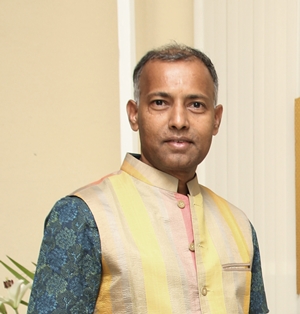Cover Story
Detailing life’s scale
BySukant Deepak
July 8, 2020 (IANSlife) Spontaneity, he says pays tribute to the unknown aspect of art, facilitating the magic we yearn for in our lives. “While making an art work, a diverse collage of emotions occupy the mind, but you don’t know where they will take us. What will the journey entail? The destination, therefore, is always shrouded in mystery, something that makes art such a magnificent process -- both internally and externally,” says Gurugram-based artist Jagannath Panda.
With his mixed-media paintings, sculptures and drawings that bring together mythology and realism, talking about urban issues, environment, migration and development, Panda, whose work is being shown at Vadehra as part of ‘A Mind of One’s Own’ says that it was in the year 2003, when he returned to India and set up base in Gurugram post completing his MFA from the Royal College of Art in the UK, that he started exploring issues of urbanisation and migration.

While the IT hub developed at a breakneck speed, with original inhabitants selling off their land to major builders who built sky-high towers, the artist observed that there were many layers to India. “So many different ‘Indias’ live together. A lot of questions came to my mind -- what does development and migration essentially mean? What do they do to us? People leaving town, new ones coming in with a certain idea of utopia. There is loss, but there is also hope. What is the larger utopia we are imagining when we are building a city or an economy? How do we deal with ecology, forests and village lands. Are we doing it right? I also started questioning myself through my painting,” says the artist who has exhibited widely across the world.
At present working on some drawings in his studio and finishing projects (“I don’t have many people, so things are going slow”), Panda is also looking at his foundation, the Utsha Foundation for Contemporary Art. “Right now, the focus is on looking at artistic models that can be created to engage artists, so that they can create work from where they are based. We strive to not only help them with their thought processes, but also art production.”
A strong advocate of public art, Panda believes that despite the fact in Indian culture, art has always been associated with the public, contemporary art is slowly ‘distancing’ itself from the general population. “Sadly, It is becoming confined to spaces inaccessible to the common man. Precisely why our foundation has made it a point to do a lot of community projects for the past eight-nine years.”
Adding that public art directly engages with people, pushing the latter’s imagination, thereby defining our collective consciousness, he says, “ Thereby, it becomes a fountainhead of multiple narratives. It is paramount that art reaches a much wider audience so as to ensure a strong cultural and creative economy can rise.”
Not in the favour of relief, but building a support system for young artists who are facing much distress in face of the pandemic, Panda says that public institutions have not been buying art for a long time and one sees little scope of engaging the practice of younger artists to an institutional space. “Therefore, it is very important that we identify and create a structure that supports their livelihoods. And that needs to be done not just for contemporary artists but also performers, especially those living in the countryside. How will they sustain? We seriously need to ensure that the many art forms on the verge of extinction don’t completely vanish. There has to be a formula that ascertains that artists don’t discontinue their practice. It’s really sad to know that young artists are leaving metros and going back to their native towns as they don’t even have money to pay rent.”
For someone who loves dealing with form and material, sculpture has always enjoyed a special place considering he likes exploring stories while engaging with materials. Panda’s sculptures are a combination of different materials like plastic toys, brocade, paper mache, and cement. And considering the fact that they play a dominant role in urban spaces, he strives to build narratives around them. “And let’s not forget that each material has its own energy. A found object carries its own history-- how it has been used, the way it was discarded and its final journey to a scrapyard.”
Attributing the combination of fine detailing and scale to the meditative process of Indian art, for example miniature, Panda says that he is forever trying to present a dichotomy. “I create a conversation and enjoy the fact that people sometimes miss the details. . There are two aspects of my painting -- one is a very large bold image, for example, the owl in the ‘Immortalise’ series, but there is also a layer of image which has a lot of fragility, going out of our eyes. I enjoy bringing and creating this conversation. I know the viewer will get only five or seven minutes to look at the large 36 feet long artwork I did for Mumbai airport, which is in the arrival corridor, still it has a lot of detail. This is also a metaphor of human life --- don’t we miss so much around us all the time?”
Influenced by Louise Bourgeois and On Kawara in his figurative work, Panda who spent time in Japan in 1997-98 says that it became his window to the Asian and European culture. “It was interesting to see the way the Japanese detailed their lives.”
(This article is a website exclusive and cannot be reproduced without the permission of IANSlife)
Sukant Deepak can be contacted at sukant.d@ians.in


